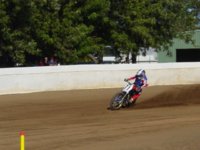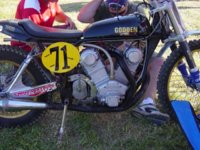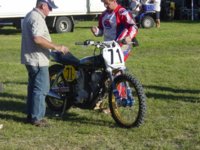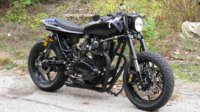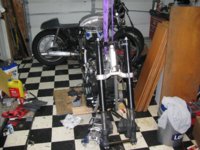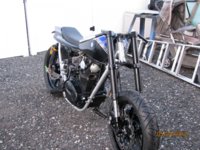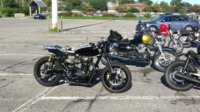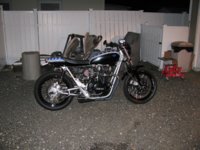Jeeter
XS650 Addict
So for those of you that have made cafe bikes or other performance customs, which fork set do you prefer?
FAT CONVENTIONAL 43MM FORKS: Many of today's flat track racers use the 43mm conventional telescopics taken from early 2000's sportbikes. Beefy and rigid, they are also well supported by the likes of Racetech and other suspension shops. And of course great brakes bolt right up to these modern forks. But I have to wonder about their weight and if that weight is offset by enough of a performance gain to justify the added weight.
INVERTED FORKS: Then there are the inverteds. Sometimes this type of fork can look cliche, simply because they are used so often in retro-build-ups. Yes, a 1975 CB750 looks pretty cool with a set of modern inverted forks on it, well at least the first ten thousand of them looked pretty cool! Now they can look cheesy if not well thought out to make sure they really work well with the bike and are a necessary addition. Otherwise they can just come off as "look at my bike, I put inverted forks on it too just like everyone else did!". Ahem .. anyhow. Does anyone know if inverted forks are lighter than conventional telescopics? The cost involved would demand that these forks offer substantial performance gains as well as substantial weight savings.
LITTLE OL' SKINNY 37mm-39mm FUNK FORKS: And of course there's the Pops Yoshimura approach, "lighter always means better in every way". I can see Pops pushing to use 37mms or 39mms and keeping the rest of the bike as light as possible rendering the somewhat smaller 39mm conventional forks far more effective and useful with each gram of weight saved.
For my Cheney Sonic Weld street tracker I am considering all three of those options, as well as one other that I may share later on.
I suppose I'd need to see what triple clamps Cheney offers, as well as locating some other triple clamp maker to get something like a set of inverted forks to fit the bike.
Ideas and opinions appreciated.
FAT CONVENTIONAL 43MM FORKS: Many of today's flat track racers use the 43mm conventional telescopics taken from early 2000's sportbikes. Beefy and rigid, they are also well supported by the likes of Racetech and other suspension shops. And of course great brakes bolt right up to these modern forks. But I have to wonder about their weight and if that weight is offset by enough of a performance gain to justify the added weight.
INVERTED FORKS: Then there are the inverteds. Sometimes this type of fork can look cliche, simply because they are used so often in retro-build-ups. Yes, a 1975 CB750 looks pretty cool with a set of modern inverted forks on it, well at least the first ten thousand of them looked pretty cool! Now they can look cheesy if not well thought out to make sure they really work well with the bike and are a necessary addition. Otherwise they can just come off as "look at my bike, I put inverted forks on it too just like everyone else did!". Ahem .. anyhow. Does anyone know if inverted forks are lighter than conventional telescopics? The cost involved would demand that these forks offer substantial performance gains as well as substantial weight savings.
LITTLE OL' SKINNY 37mm-39mm FUNK FORKS: And of course there's the Pops Yoshimura approach, "lighter always means better in every way". I can see Pops pushing to use 37mms or 39mms and keeping the rest of the bike as light as possible rendering the somewhat smaller 39mm conventional forks far more effective and useful with each gram of weight saved.
For my Cheney Sonic Weld street tracker I am considering all three of those options, as well as one other that I may share later on.
I suppose I'd need to see what triple clamps Cheney offers, as well as locating some other triple clamp maker to get something like a set of inverted forks to fit the bike.
Ideas and opinions appreciated.

